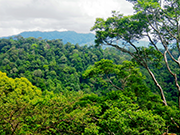Ants (Hymenoptera: Formicidae) are often considered to be “keystone” arthropods in terrestrial ecosystems because of the combination of their typically high abundances and prominent functional roles in biological control of plant pests, in habitat alteration, and in nutrient recycling (e.g., Hölldobler and Wilson, 1990). Comprising as much as 80% of the arthropods in tropical rain forest canopies (Davidson and Patrell-Kim, 1996; Tobin, 1995), ants were once thought to feed mainly as predators of canopy arthropods (Floren and Linsenmair, 2002). However, this conjecture conflicted with observations that their abundance and biomass regularly exceeded those of their supposed prey (Davidson et al., 2003, summarizing “Tobin’s ant biomass paradox”). Further suggesting that canopy ants could feed at lower trophic levels, stable isotope analyses (δ15N values) revealed that they might even be herbivorous (Davidson et al. 2003; Blüthgen et al. 2003).
These results are particularly striking because plant-based nutrition is usually low in nitrogen, which is crucial for construction of animal bodies. One possible explanation for this phenomenon is the existence of ant relationships with microbes that either preferentially recycle ‘light’ nitrogen (14N) (Davidson et al., 2003; Cook and Davidson, 2006) or which upgrade N-based resources (Feldhaar et al., 2007, for endosymbiotic bacteria Blochmannia of carpenter ants Camponotus). Additionally, considerable evidence suggests that symbiotic microorganisms of ants may even fix atmospheric nitrogen (Anderson et al., 2012; Eilmus and Hei, 2009; Pinto-Tomás et al., 2009, Russell et al., 2009; Stoll et al., 2009). For example, Pinto-Tomás et al. (2009) revealed N2 fixation by symbiotic bacteria within leaf-cutter ants (tribe Attini) and documented this as a previously unrecognized nitrogen source in the whole neotropical ecosystem. Similarly, the pioneering study of the microbiomes of Cephalotes varians (subfamily Myrmicinae) demonstrated a number of ant-specific bacterial lineages that likely function as nutritional symbionts (Kautz et al., 2012). These and other studies confirm that microorganisms play key roles in shaping the evolution and diversity of insects including ants (e.g. Douglas, 2011; Feldhaar, 2011). However, we are just beginning to understand the depth, breadth and functional range of such associations. Overall, diets of many arboreal ants remain poorly characterized, and so ecological mechanisms that make these ants so successful remain largely obscured. Evidently mutualistic associations with eukaryotic microorganisms such as fungi also contribute to the ecological success of ants, through a diversity of mechanisms including nutrition, nest hygiene, and nest stabilization. Intensively studied fungus-growing ants (Attini) depend on mutualistic associates of basidiomycete fungi producing specialized structures (gongylidia) as food, and on antibiotic-producing actinomycete bacteria (see Schultz and Brady, 2008). Fungi cultivated by Attini are constantly attacked by mycoparasitic fungi (Escovopsis) and generalist microbes. To maintain their efficient agriculture, these ants evolved an integrated disease management system based on both biochemical defenses from bacteria and antiseptic secretions of their own metapleural glands (Fernández-Marín et al., 2013). Although Currie (2008) noticed that black yeast symbionts compromise the efficiency of antibiotic defences in Attini, other black yeasts have been implicated in the establishment of carton walls in ant-inhabited (plant) domatia and other nest sites (Vogelmayr et al., 2009). Candida edax has been found in the infrabuccal pocket of a carpenter ant (Camponotus vicinus), where it is retained year round even in seasons when ants are not feeding. In a preliminary experiment, C. vicinus colonies benefit from their yeasts, perhaps via a role in food processing by enzymatic breakdown of buccal pellet contents (Mankowski and Morrell, 2004).
 The mechanisms by which organisms compete for territory and resources are key processes in ecology. The carpenter ants in the Camponotus (Colobopsis) cylindricus complex (‘COCY’, or exploding ants), that dominate arboreal habitats in rain forests on Borneo, have evolved a so-far unique and remarkable behaviour: In territorial combat with enemy ants and other arthropods they sacrifice themselves by rupturing (autothysis) and releasing sticky and irritant contents of their hypertrophied mandibular glands to kill rivals. Voluntary self-sacrifice is very rare in nature, undoubtedly due to attendant fitness losses. It is known in termites and honeybees, where effective deployment in defense of the nest may leave self-sacrificing workers with indirect fitness. Contrary to that, workers of COCY ants forage solitarily and explode during one-on-one confrontations far from nests, thus defending the territory against potential competitors probably for continuously renewing foods such as phyllosphere microbes.
The mechanisms by which organisms compete for territory and resources are key processes in ecology. The carpenter ants in the Camponotus (Colobopsis) cylindricus complex (‘COCY’, or exploding ants), that dominate arboreal habitats in rain forests on Borneo, have evolved a so-far unique and remarkable behaviour: In territorial combat with enemy ants and other arthropods they sacrifice themselves by rupturing (autothysis) and releasing sticky and irritant contents of their hypertrophied mandibular glands to kill rivals. Voluntary self-sacrifice is very rare in nature, undoubtedly due to attendant fitness losses. It is known in termites and honeybees, where effective deployment in defense of the nest may leave self-sacrificing workers with indirect fitness. Contrary to that, workers of COCY ants forage solitarily and explode during one-on-one confrontations far from nests, thus defending the territory against potential competitors probably for continuously renewing foods such as phyllosphere microbes.